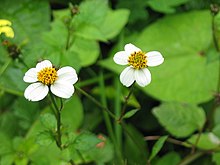Euptoieta hegesia
| Euptoieta hegesia | ||||||||||||
|---|---|---|---|---|---|---|---|---|---|---|---|---|

Euptoieta hegesia , |
||||||||||||
| Systematics | ||||||||||||
|
||||||||||||
| Scientific name | ||||||||||||
| Euptoieta hegesia | ||||||||||||
| ( Cramer , 1779) |
Euptoieta hegesia is a butterfly fromNorth, Central and South Americafromthe noble butterfly family (Nymphalidae).
features
butterfly
The moths reach an average wingspan of 65 to 75 millimeters, with the females being slightly larger than the males. In both sexes, the orange or yellow-brown wing tops are patterned with black spots and lines. A black row of dots can be seen in the submarginal region . The black veins on the upper side of the forewing stand out clearly. The hem is dark brown. The disk region on the upper side of the hind wing is slightly brightened. The undersides of the wings are marbled slightly light brown to reddish brown. Mother-of-pearl spots are missing.
Caterpillar, pupa
Adult caterpillars are rust-red in color and show a white side stripe. Each body segment is provided with branched black thorns. There are two short, thin, straight horns on the head, which end like a piston. The doll is designed as a tumble doll and has a dark brown color. A T-shaped black mark can be seen on the wing sheaths. Small, gold-colored, pointed bumps stand out from the entire surface of the body.
Similar species
Euptoieta claudia differs in the darker disk and basal region on the upper side of the hind wing and the contoured marbling on the underside of the hind wing.
Distribution, habitat and subspecies
The distribution of Euptoieta hegesia extends from the southern United States and the West Indies to Argentina . Individual specimens have also been found in southern California . The species prefers open subtropical areas. In addition to the in the Dominican Republic , as well as Jamaica and Cuba occurring nominate Euptoieta hegesia hegesia following are subspecies known:
- Euptoieta hegesia meridiania graver , 1938 US, Mexico , Panama , Ecuador and Brazil
- Euptoieta hegesia watsoni Comstock , 1944 Puerto Rico
Way of life
The moths fly in several generations throughout the year. They like to suckle on flowers for food intake, for example on convertible florets ( Lantana ) or hairy two-toothed teeth ( Bidens pilosus ) and sometimes take in minerals from fresh excrement . The eggs are laid on the leaves or stems of the food plant. The caterpillars feed on the flowers and leaves of various plants, for example saffron mallow ( Turnera ), passion flower ( Passiflora ) or hybanthus species.
Individual evidence
- ↑ Information on Art
- ^ A b James A. Scott: The butterflies of North America. Stanford University Press, Stanford, California 1986, ISBN 0-8047-1205-0 , p. 336
- ↑ a b Markku Savela: Tanaecia Butler, (1869) - distribution. In: Lepidoptera and some other life forms. Retrieved January 6, 2019 .
literature
- James A. Scott: The butterflies of North America. Stanford University Press, Stanford, California 1986, ISBN 0-8047-1205-0
Web links
- butterfliesofcuba - Butterflies of Cuba
- learnaboutbutterflies - Mexican Fritillary

